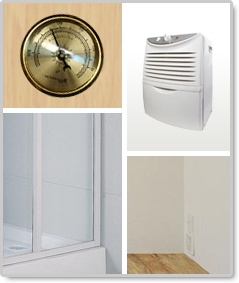Protecting Your Family From Mold

Here are some suggestions for preventing and managing mold around your home:
Keep indoor humidity low
The key to controlling mold control is controlling moisture in your home. Mold grows when the spores come in contact with wet surfaces. Here are a couple ways to manage the moisture content in your home:
Monitor your humidity
For $15- $40 you can get a humidity gauge to measure the moisture level in your home. Ideally, you will want to maintain the humidity in your home to below 50% relative humidity to deter the growth of mold.
Use a dehumidifier
If you find that the humidity level in your home (especially in the summertime, or anytime in a basement) is above about 50%, then you should consider getting a dehumidifier to reduce the water content of the air in your home (see types, costs, and reviews of dehumidifiers).
Avoid cardboard storage boxes
Avoid using cardboard boxes to store items, because cardboard attracts moisture. This is especially important if your storage areas are in your basement or attic, which can be areas where the humidity is the highest in your home. Instead of cardboard, it is suggested that you use plastic containers instead (see types, costs, and reviews of plastic storage boxes).
Increase ventilation
This tip is especially for the bathroom. After showers, turn on an exhaust fan or open a window in your bathroom. Places like your bathroom that are often damp need to be well ventilated in order to avoid mold growth. A constantly wet bathroom shower curtain, for example, is a haven for mold, and will need to be cleaned or replaced frequently.
Regularly clean your bathtub and shower walls
Damp bathtubs and showers are a breeding ground for molds. Therefore at least twice a month you should use a commercial mildew cleaner and scrub brush to give your tub and shower walls a thorough cleaning. When performing this task, take care to pay special attention to the area surrounding your shower grout, as it is very susceptible to mold.
Do a “smell test” for invisible mold
Even if you can’t see mold, it does not mean it is not there. If areas of your home smell damp and musty, then the mold is hiding somewhere. Some common places are the back side of the drywall, wallpaper, paneling, inside ductworks, or in roofing materials above ceiling tiles. If you can smell it, but can’t locate where the mold actually is, then you should call in a professional.
Test areas that you suspect have problems
You can purchase relatively inexpensive home mold testing kits at most good hardware stores. While these are not reliable for all types of possible molds, it is a good place to start.
Consider the size of the mold problem
If the moldy area is less than 10 square feet (approximately a 3 feet by 3 feet), then you can do a cleanup on your own. Mold problems bigger than this requires a professional with experience in mold cleanups. If you do plan to tackle the smaller problem on your own, here are a few things to keep in mind:
Use vinegar for mold clean-up.
Vinegar is an effective way to clean mold from just about any household surface. Mix 3 parts of white distilled vinegar with 3 parts water. Use a sponge with the solution and soak the moldy area and let it sit for a few minutes. Wipe down with a dry cloth afterward.Avoid breathing in the mold spores.
Mold spores can easily become airborne, so cover your nose and mouth when you are doing the cleanup. The Environmental Protection Agency recommends that you wear an N-95 respirator which can be easily bought for $12-$25 (see types, costs, and reviews of N-95 respirators). Be sure to open windows and have plenty of fresh air ventilation while you are working.Use long gloves.
Never touch the mold with your bare hands. Gloves that extend to the middle of your forearm are recommended. And the gloves you use for mold cleanup should be disposed of afterward, and not re-used.Wear goggles.
You should absolutely avoid getting mold or mold spores in your eyes. Always wear goggles which have no ventilation at the sides (see types, costs, and reviews of protective goggles).Identify the type of mold.
Mold can come in many colors: white, yellow, rust, black, etc. By far the most deadly mold is the black mold which can be life-threatening. If you see black mold, then stop immediately and leave the house, then call in a professionalSummary
Damage from mold can be very expensive and potentially dangerous, and it is best to take routine preventative measures such as monitoring, reducing and controlling your home’s humidity levels. And if you do find any mold in your home, if it is a small area you can treat it yourself, but it if is a large project, it is best to call in professionals who are trained in how to control mold from becoming airborne and spreading throughout your house.
Related Articles . . .
Reducing Humidity in Your Home: Why & How-To
As we head towards the hot summer months, home humidity becomes a problem. This article discusses: the benefits of reducing home humidity; signs that your humidity is too high; and steps you can take to reduce humidity in your home.
Why You Need to Keep Rain Away From Your Foundation
Your home's gutters and downspouts play a very important role in protecting your home's foundation from water damage. This article explains why and how you should take care of your home's gutters and downspouts.
How to Allergy-Proof Your Home
If someone in your family suffers from allergies or asthma, you will want to take steps to eliminate the triggers in your home environment that make them miserable. Here are 21 tips to help you allergy-proof your home.
An Allergy Sufferer's Guide to Carpet Care
If you or someone in your family suffers from allergies, here are some tips to help make your carpeting less of a burden on allergies. This article covers tips for vacuuming, cleaning and replacing your carpets.
Guide to Choosing & Changing HVAC Air Filters
For saving energy and improving air quality, changing the air filters for your furnace is important. This article discusses: why you should change your air filter; how often to do it; how to choose the right filter; and how to do-it-yourself.









